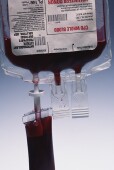 |
 |
 |

Report Confirms Source of Contaminated Heparin
A man-made chemical was added to the blood thinner imported from China|
|
HealthDay
Wednesday, December 3, 2008
 WEDNESDAY, Dec. 3 (HealthDay News) -- A final report on the deadly contamination of the blood thinner heparin confirms that the problem was caused by a man-made chemical that was added to batches of the drug imported from China, U.S. investigators report.
WEDNESDAY, Dec. 3 (HealthDay News) -- A final report on the deadly contamination of the blood thinner heparin confirms that the problem was caused by a man-made chemical that was added to batches of the drug imported from China, U.S. investigators report.
The crisis, which began last November, resulted in 152 adverse reactions and as many as 81 deaths in the United States. The Chinese heparin, contaminated with the chemical oversulfated chondroitin sulfate, was found in at least 10 countries, according to federal officials.
"The last case was reported on January 31," said Dr. Priti R. Patel, a medical epidemiologist with the U.S. Centers for Disease Control and Prevention, and a member of the investigation team that wrote the report.
Published in the Dec. 4 issue of the New England Journal of Medicine, the report "describes the adverse reactions caused by the contaminant" and links it to a specific substance, Patel said. The reactions included a drastic drop in blood pressure, nausea and shortness of breath, starting within 30 minutes after the administration of the heparin.
"There is a definite link between this contaminant and the patients who had these reactions," she said.
The first reports of such reactions among hospital patients given heparin came in November 2007. Eventually, cases were reported in 13 states. Investigators found a common thread in those cases: heparin marketed by Baxter Healthcare, of Deerfield, Ill., which got its supplies from China.
Raw heparin is derived from pig intestines. It is given intravenously to prevent blood clots during certain kinds of surgery, and also is used by people with kidney disease requiring dialysis. In China, heparin often is made by small, unregulated companies.
Chondroitin sulfate is a natural substance extracted from animal cartilage that can be used in supplements to treat arthritic joints. Oversulfation results from processing of the substance. Most of the reactions reported in the United States occurred in dialysis centers among people given high initial doses of heparin, the report found.
The heparin incident illustrates the importance of health providers reporting untoward incidents to regulatory authorities, Patel said. "Public health always relies on providers to make these reports," she said. "If they don't report, we have no way of finding what is wrong and correcting it. We are always asking people to be on their toes and communicate any problems."
Meanwhile, a letter in the same issue of the journal described a much easier way of identifying oversulfated chondroitin sulfate (OSCS) contamination in heparin -- should it occur again.
The two tests now mandated to detect contamination -- capillary electrophoresis and nuclear magnetic resonance spectroscopy -- are "technically challenging, not widely established and not easily applicable in clinical practice," said the letter from researchers at Christian-Albrechts University in Kiel, Germany.
That letter reported successful identification of OSCS contamination in heparin by use of one of the most common tests in medical practice --measuring prothrombin time, the time required for blood to clot, or coagulate. Studies show that coagulation time goes down as the amount of OSCS in a blood sample goes up, the letter said.
The test is widely available because many people, such as those taking the blood-thinning drug Coumadin for conditions such as atrial fibrillation, must have their clotting time assessed periodically.
"This test is applicable for any clinical laboratory, in the United States and Europe," said Susannne Alban, a professor of pharmacy and co-author of the letter. "It could be used as a pre-test, to detect the problem before any symptoms are seen."
HealthDay
Copyright (c) 2008 ScoutNews, LLC. All rights reserved.
Related News:
More News on this Date
Related MedlinePlus Pages:
| Home | Health Topics | Drugs & Supplements | Encyclopedia | Dictionary | News | Directories | Other Resources | |
| Disclaimers | Copyright | Privacy | Accessibility | Quality Guidelines U.S. National Library of Medicine, 8600 Rockville Pike, Bethesda, MD 20894 National Institutes of Health | Department of Health & Human Services |
Date last updated: 04 December 2008 |




